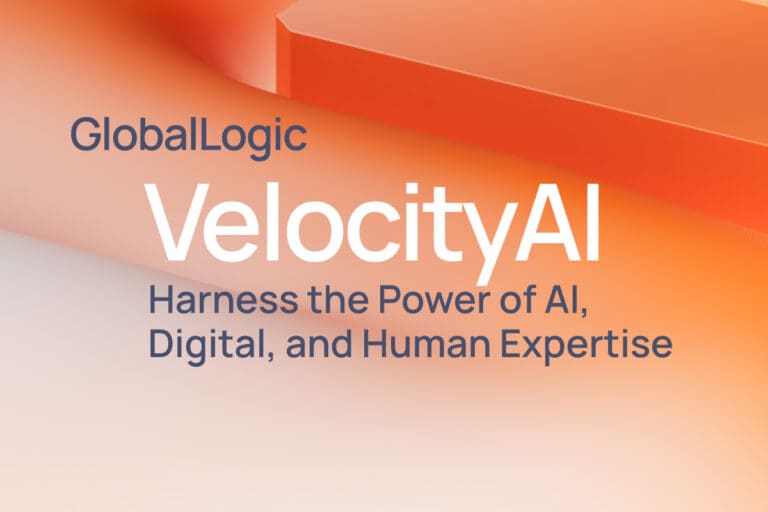- Services
Technology Capabilities
Technology Capabilities- Product Strategy & Experience DesignDefine software-driven value chains, create purposeful interactions, and develop new segments and offerings.
- Digital Business TransformationAdvance your digital transformation journey.
- Intelligence EngineeringLeverage data and AI to transform products, operations, and outcomes.
- Software Product EngineeringCreate high-value products faster with AI-powered and human-driven engineering.
- Technology ModernizationTackle technology modernization with approaches that reduce risk and maximize impact.
- Embedded Engineering & IT/OT TransformationDevelop embedded software and hardware. Build IoT and IT/OT solutions.
- Industries
- GlobalLogic VelocityAI
- Insights
BlogsDecember 16, 2024Gene LeybzonAccelerating Digital Transformation with Structured AI Outputs
This code produces the following output that can be imported into the candidate trackin...
 BlogsOctober 30, 2024Yuriy Yuzifovich
BlogsOctober 30, 2024Yuriy YuzifovichAccelerating Enterprise Value with AI
Discover how financial services integrations are transforming from standalone offerings...

- About Us
Press ReleaseGlobalLogicMarch 11, 2025GlobalLogic Launches VelocityAI to Harness the Power of AI, ...
VelocityAI combines advanced AI technologies with human expertise, helping businesses r...
 Press ReleaseGlobalLogicJanuary 10, 2025
Press ReleaseGlobalLogicJanuary 10, 2025GlobalLogic Announces Leadership Change: Srini Shankar Appointed ...
SANTA CLARA, Calif.–January 10, 2025– GlobalLogic Inc., a Hitachi Group Com...

- Careers
Published on December 16, 2024Accelerating Digital Transformation with Structured AI Outputs
View all articles Gene LeybzonChief ArchitectShareRelated Content
Gene LeybzonChief ArchitectShareRelated Content GlobalLogic26 February 2025
GlobalLogic26 February 2025 GlobalLogic17 February 2025View All Insights
GlobalLogic17 February 2025View All Insights GlobalLogic17 February 2025
GlobalLogic17 February 2025Let's start engineering impact together
GlobalLogic provides unique experience and expertise at the intersection of data, design, and engineering.
Get in touchAgileAI GovernanceAnalyticsCommunications and Network ProvidersEnterprises increasingly rely on large language models (LLMs) to derive insights, automate processes, and improve decision-making. However, there are two significant challenges to the use of LLMs: transforming structured and semi-structured data into suitable formats for LLM prompts and converting LLM outputs back into forms that integrate with enterprise systems. OpenAI’s recent introduction of structured outputs to their API addresses these pain points directly. This feature, available in their latest models like GPT-4o, enables businesses to generate precise, reliable structured data from AI interactions, bridging the gap between innovative AI capabilities and the practical demands of enterprise platforms. This feature, supported by OpenAI’s newest models like GPT-4o, enables precise and reliable generation of structured data from AI interactions.
This development can assist enterprise architects in implementing rapid prototyping, accelerating the deployment of new services, and enhancing their organization’s agility to adapt to market changes or operational demands.
Structured outputs are crucial in generative AI (GenAI) deployments, as they enhance operational scalability, ensure governance, and foster system interoperability across the enterprise. Structured outputs also work well with automation workflows, allowing systems to handle increased operational loads with minimal human oversight, and optimize resource allocation by freeing up personnel for critical tasks.
This automation streamlines integration with legacy systems, ensuring compatibility without the need for disruptive system overhauls, and enhances data quality and compliance with regulatory standards—key considerations in regulated industries.
Read on to discover how using structured output can improve your ability to hire top talent. We present an example of extracting relevant data from a resume and then exporting that data into an applicant tracking system. By demonstrating how useful structured output can be, you can see how it can be applied to difficulties unique to your business.
What is Structured Output?
Structured output from an AI model are responses to queries generated in a structured JSON format. This JSON can define various attributes and values based on the schema provided. For example, if an AI is tasked with extracting information from text, it can output a JSON object with specific fields for each piece of information.
Structured outputs improve the utility of AI, making it a more robust tool to enhance operational efficiency, reliability, and accuracy for the digital transformation journey.
When AI models generate data following a defined schema, the output is consistently structured. This reliability is crucial for businesses that depend on systematic data inputs, as it allows seamless integration into existing systems without requiring manual verification or reformatting. Structured outputs eliminate the variability often seen with flexible AI responses, where the format and type of information can vary. Reducing the need for manual data parsing and restructuring saves time, enhances efficiency, and streamlines information processing.
Recommended reading: GlobalLogic Named a Leader in Generative AI Services by ISG Provider Lens™
Practical Example
Let’s consider a scenario where an HR department needs to extract details from submitted resumes. The desired output is structured data that categorizes the person’s name, skills, and years of experience to submit to a candidate tracking system. The resume may look like this:
Jane A Smith
Senior AI Engineer | Machine Learning Specialist
Email: jane.smith@example.com
Phone: +1 987 654 3210Experience
GlobalLogic
Senior AI Engineer | 2020 – Present- Lead AI projects, focusing on natural language processing (NLP) and generative AI models.
- Developed custom GPT-based models for enterprise applications, improving efficiency by 35%.
- Managed a cross-functional team to implement AI-driven solutions in healthcare, resulting in a 20% reduction in operational costs.
- Designed a scalable machine learning pipeline for processing large datasets, reducing processing time by 40%.
Acme Tech Solutions
AI Researcher | 2017 – 2020- Pioneered deep learning algorithms for computer vision, enhancing object detection accuracy by 25%.
- Collaborated on a multi-year project developing AI-driven predictive analytics for financial institutions, boosting decision-making accuracy.
Education
Ph.D. in Artificial Intelligence
Stanford University | 2016
M.Sc. in Computer Science
University of California, Berkeley | 2012Skills
- Programming Languages: Python, R, Java
- AI & ML Frameworks: TensorFlow, PyTorch, Keras
- Tools: Docker, Kubernetes, Git
- Specialties: Generative AI, NLP, Deep Learning, Predictive Analytics
(Please note that this is not a real resume, it is AI-generated content for a fictitious candidate.)
The HR department wants to extract the following information from this resume:- Name
- Phone number
- Experience
- Education
With the new capability of OpenAI API and models to support structured output, a company can use the following code to extract the desired data from the resume:
from openai import OpenAI client = OpenAI() # Read resume from external file with open("resume.txt", "r") as file: resume_text = file.read() # Define the structured output schema schema = { "type": "object", "properties": { "name": {"type": "string"}, "email": {"type": "string"}, "phone": {"type": "string"}, "experience": {"type": "array", "items": {"type": "string"}}, "education": {"type": "string"}, }, "required": ["name", "email", "phone", "experience", "education"], } # Make the API call to extract data response = client.chat.completions.create( model="gpt-4o-2024-08-06", messages=[ {"role": "system", "content": "Extract information from the resume."}, {"role": "user", "content": resume_text}, ], functions=[ { "name": "extract_resume_data", "parameters": schema, } ], function_call="auto" ) # Print the extracted data print(response.choices[0].message.function_call.arguments)This code produces the following output that can be imported into the candidate tracking system for additional processing:
{ "name": "Jane A Smith", "email": "jane.smith@example.com", "phone": "+1 987 654 3210", "experience": [ "GlobalLogic: Senior AI Engineer | 2020 - Present", "Lead AI projects, focusing on natural language processing (NLP) and generative AI models.", "Developed custom GPT-based models for enterprise applications, improving efficiency by 35%.", "Managed a cross-functional team to implement AI-driven solutions in healthcare, resulting in a 20% reduction in operational costs.", "Architected a scalable machine learning pipeline for processing large datasets, reducing processing time by 40%.", "Acme Tech Solutions: AI Researcher | 2017 - 2020", "Pioneered deep learning algorithms for computer vision, enhancing object detection accuracy by 25%.", "Collaborated on a multi-year project developing AI-driven predictive analytics for financial institutions, boosting decision-making accuracy." ], "education": "Ph.D. in Artificial Intelligence, Stanford University | 2016; M.Sc. in Computer Science, University of California, Berkeley | 2012" }Recommended reading: Powering the intelligent enterprise with Enterprise-Grade AI (Fact Sheet)
Leveraging Structured Outputs to Drive Enterprise Efficiency
Structured outputs make it easier for businesses to integrate AI solutions into existing systems. Producing results in a consistent, predefined format will help you improve data reliability, simplify operations, and support better decision-making. These outputs also eliminate the need for manual data formatting, saving time and reducing operational effort.
Addressing challenges like data security, scalability, and system integration requires a thoughtful and proven approach. With our extensive expertise in AI and digital transformation, GlobalLogic helps businesses deploy secure, flexible solutions that work seamlessly across cloud and on-premises systems. This ensures the adaptability needed to meet evolving technology and business demands.
Structured outputs are particularly valuable in industries with strict regulations or legacy systems, where they enable faster prototyping, smarter resource allocation, and improved system compatibility. Incorporating these strategies enables organizations to unlock the full potential of AI and remain competitive in a rapidly changing market.
At GlobalLogic, we specialize in integrating AI and GenAI into enterprise frameworks to drive innovation and efficiency. Our unique Platform-of-Platforms architecture simplifies the complexities of modern IT ecosystems, delivering secure, scalable, and adaptable solutions tailored to your business needs.
Remember, structured outputs offer key advantages for businesses:
- Consistent, actionable results that enhance data integration and interoperability.
- Streamlined operations with reduced manual effort and faster processing.
- Scalable solutions to meet evolving demands while optimizing resources.
As a leader in AI-powered digital transformation , GlobalLogic is committed to helping organizations turn cutting-edge technology into real, measurable impact. Partner with us to shape the future of your business – learn more here.
References
[1] Introduction to Structured Outputs, OpenAI Cookbook.
[2] Using JSON Schema for Structured Output in Python for OpenAI Models, Microsoft DevBlogs.
[3] Structured outputs in LLMs: Definition, techniques, applications, benefits, LeewayHertz.com
[4] Generate structured output with the Gemini API, Google AI for Developers.
